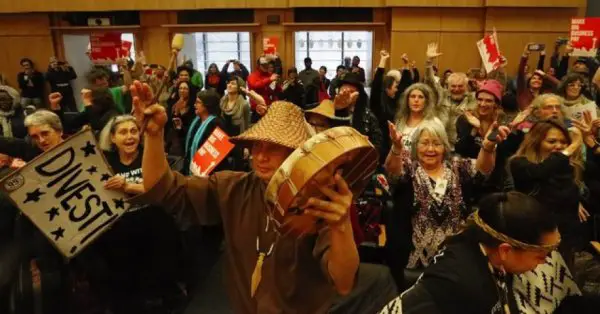Seattle City Council Pulls Out Of A $3 Billion Investment For The Dakota Access Pipeline
Tags: News

A decision has been made by a committee of the Seattle City Council after vote results favoured a divestment of $3 billion of city money from Wells Fargo, following the bank’s role in the construction of the recently reinstated building of the Dakota Access Pipeline.
According to a record by the Seattle Times, council members Kshama Sawant and Tim Burgess co-sponsored the bill. At the time that the bill was being heard before the Affordable Housing, Neighborhoods and Finance Committee, pipeline opposition activists were gathered outside in protest against the building of the pipeline. Huge campaigns and public pressure to divest from the banks that are contributing to the building of the pipeline is what led to the preliminary hearing.
Energy Transfer Partners was forced to stop the construction of the pipeline when the U.S. Army Corps of Engineers stated that a full environmental impact assessment must first be carried out. The halting of the project was seen as a small victory and was expected to last quite a while, whilst officials assessed the safety of the Dakota Access undercutting the Missouri River’s Lake Oahu reservoir. This area is the sole source of drinkable water for the Standing Rock Sioux Tribe, and around 18 million people are estimated to obtain their water from where the pipeline will cut through.
However, President Donald Trump was quick to signal the approval of both the Dakota Access and Keystone XL Pipelines, meaning that the projects were immediately started up again. Shortly after this announcement, North Dakota Senator John Hoeven released the following statement, which brought more bad news for water protectors who are camped near the path of the final segment of construction:
“Today, the Acting Secretary of the Army Robert Speer informed us that he has directed the Army Corps of Engineers to proceed with the easement needed to complete the Dakota Access Pipeline. This will enable the company to complete the project, which can and will be built with the necessary safety features to protect the Standing Rock Sioux Tribe and others downstream. Building new energy infrastructure with the latest safeguards and technology is the safest and most environmentally sound way to move energy from where it is produced to where people need it.
“We are also working with the Corps, the Department of Justice, the Department of Interior and the Department of Homeland Security to secure additional federal law enforcement resources to support state and local law enforcement. On Sunday, 20 additional Bureau of Indian Affairs law enforcement officers arrived at Standing Rock to assist local authorities. Also, the Standing Rock Sioux Tribal Council has asked the protesters to leave the campsite on Corps land. This has been a difficult issue for all involved, particularly those who live and work in the area of the protest site, and we need to bring it to a peaceful resolution.”
In light of orders to continue with the pipeline, many people believe that the divestment from banks who are financing the project is the only option going forwards. According to the Times, Wells Fargo manages more than $3 billion of Seattle’s operating budget, which includes “a bi-weekly payroll of $30 million for about 12,000 employees. The average daily balance in the city’s account with Wells Fargo is about $73 million. Wells Fargo, along with 16 other banks, is a lender to the Dakota Access Pipeline project. Wells Fargo has $120 million in a $2.5 billion credit agreement funding the pipeline project, according to Jessica Ong, with Wells Fargo corporate communications.”
The strategy of encouraging disinvestment from banks has worked in favour of the pipeline previously, as back in November, Norway’s largest bank, DNB, pulled all its assets from the project after they received a petition from Greenpeace which had gathered over 120,000 signatures.
THIS ARTICLE IS OFFERED UNDER CREATIVE COMMONS LICENSE. IT’S OKAY TO REPUBLISH IT ANYWHERE AS LONG AS ATTRIBUTION BIO IS INCLUDED AND ALL LINKS REMAIN INTACT.
IMAGE CREDIT: (Ken Lambert / The Seattle Times)

Leave Comment: